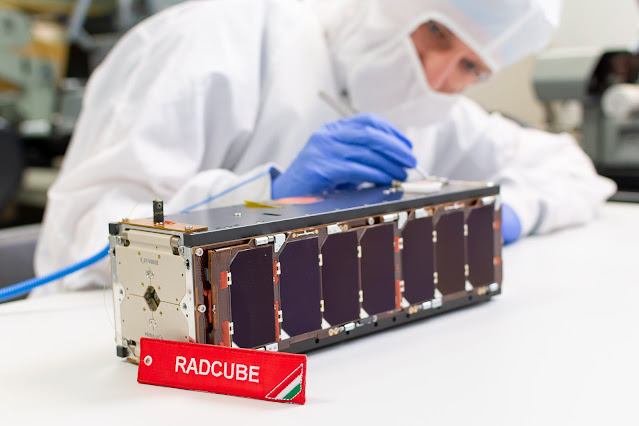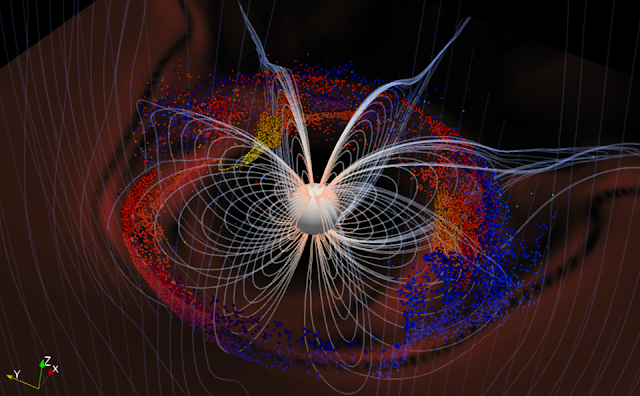ESA - RadCube Mission patch.
Sept. 23, 2022
Magnetic technology more typically found in your smartphone or computer hard drive has been flight-tested aboard a shoebox-sized satellite, employed to help monitor space weather in Earth orbit. The ‘magnetoresistive’ magnetometer design proven by ESA’s RadCube mission will now be flown on the Gateway station, set to orbit around the Moon.
RadCube reaches out
“We flew a pair of three-axis sensors employing magnetoresistive chips aboard RadCube, one in the body of the nanosatellite and one at the end of an 80-cm boom developed by Astronika in Poland, which allows it to escape any magnetic noise from RadCube itself,” explains Jonathan Eastwood from Imperial College London in the UK.
RadCube CubeSat
“Known as MAGIC, these sensors are an order of magnitude smaller than the traditional science magnetometers that our team produces for ESA’s planetary missions such as Solar Orbiter and the Juice mission to Jupiter, but they have still proven capable of reaching the ESA-set performance standards for space weather monitoring. The outboard sensor operated for the first six months of RadCube’s orbital life while the inboard sensor is still returning data to this day.”
RadCube boom deployment test
Magnetic chips made ready for space
Magnetoresistive chips are small, solid state, circuits that are mass produced for terrestrial markets, whose electrical resistance depends on the local magnetic field. They are commonplace inside smartphones for instance, used to identify magnetic north to help the phone to fix its orientation, and within the heads of hard drives, from where they read magnetically-etched computer memory.
MAGIC sensor
Dr Eastwood adds: “The classical ‘fluxgate’ magnetometer instruments we manufacture for large-scale ESA missions are rings of magnetically sensitive material wrapped in wire, analog in nature, but capable of exquisite magnetic measurements. However these magnetometers have set minimum size, mass and power levels, and the electronics box that controls them is almost as big as the entire RadCube nanosatellite.
“The MAGIC sensor by contrast is based on magnetoresistive chips we simply bought over the counter, and then boosted their performance for space. What we did was screen the samples to make sure we selected the very best chips for the sensor, while also designing bespoke control electronics to maximise their operating performance. The result is a miniature, low cost sensor that can be flown on many different platforms, such as a small satellite constellation monitoring space weather, or mini-landers onto planets or asteroids.
In-orbit demonstration
“The final step was to actually test MAGIC’s performance in space, which was made possible via the ‘Fly’ element of ESA’s General Support Technology Programme, supporting a wide variety of small satellites and CubeSats to give the European space sector plentiful opportunities for early in-orbit demonstration of new space technology.”
RadCube during ground testing
CubeSats are satellites assembled from standardised 10-cm boxes. RadCube is a ‘3-unit’ CubeSat, launched in August 2021 on ESA’s Vega launcher. Tasked with demonstrating miniaturised payloads for space weather monitoring, its development was led for ESA by C3S in Hungary who also provided their new CubeSat platform, along with the country’s Centre for Energy Research contributing its payload controller and a radiation telescope. An ESA team contributed the latest in the Chimera family of payloads, testing commercial-off-the-shelf computer components for space.
Dr Eastwood notes: “We realised MAGIC was a good fit for the RadCube mission, and the UK Space Agency agreed to fund us via GSTP. The energetic particles that the rest of the RadCube payload measures spiral around and along the Earth’s magnetic field lines to the CubeSat’s orbit, so having magnetic field measurements puts these radiation measurements in context, giving a much better overall picture of what is going on.”
Testing for Space Safety
ESA’s Space Safety programme is leading the development of operational space weather monitoring, because solar-wind-driven perturbations in Earth’s magnetic field can have a variety of effects on Earth and space infrastructure, including satellites in orbit and communications and power lines on the ground. In 1989, famously, the Canadian province of Quebec suffered an extended blackout after elements of its power grid were affected by induced currents.
Planetary-scale space weather
“We took the ESA standard for space weather observations and used that to set our operating requirements, and the good news is that MAGIC met them,” comments Dr Eastwood. “We also had the opportunity to compare MAGIC data with those of one of our traditional fluxgate magnetometers when ESA’s Solar Orbiter came back to Earth’s vicinity during a flyby, helping it on its way towards the inner Solar System.
Solar Orbiter flyby of Earth
“We have also been cross-comparing with ESA’s magnetic-field-measuring Swarm satellites, and looking into how magnetoresistive sensors in the future might be used to extend the reach of Swarm measurements.”
Orbital extremes
The outboard sensor ceased functioning earlier this year, probably due to the wide temperature extremes experienced on the end of the boom throughout RadCube’s polar low-Earth orbit, with daytime to nighttime shifts every 90 minutes involving thermal cycling of up to 100°C. Knowledge of the failure is guiding the design of future MAGIC iterations. The inboard sensor remains operational, although its measurements are dominated by the magnetic environment of RadCube itself, when artificial sources of magnetic field such as the reaction wheels of the attitude control system are operating.
RadCube launch
“We’re increasingly confident that the inboard sensor can meaningfully measure external geomagnetic events,” adds Dr Eastwood. “RadCube operations have been adapted to fly the satellite in as magnetically quiet a state as possible when the magnetometer is operated to minimize the noise, and also it might be possible to apply machine learning to clean its data to get to the external variations we’re most interested in.”
Roger Walker, overseeing ESA’s technology CubeSats, adds: “It is a real advantage of in-orbit demonstrations aboard comparatively quick and cheap missions using CubeSat platforms that researchers get to experiment with new technologies before they might be used operationally on a big flagship mission, where risk is kept as low as possible.”
Magnetic Moon exploration
Now that MAGIC has been proven in low-Earth orbit, the same sensor will be headed for cislunar space as part of the European Radiation Sensors Array, an ESA-supported ‘space weather station’ for the Gateway station in lunar orbit.
Gateway
Jonathan Eastwood explains: “The Gateway itself will be a magnetically noisy environment, but we should be able to detect the weaker magnetic signature of the solar wind and the deep ‘magnetotail’ of Earth’s magnetic field, through which the station will pass once per month, helping assess the safety of the orbital environment for its human crews."
General Support Technology Programme
ESA’s optional GSTP works with European industry to progress new technologies to the stage where they are ready for space and the open market. At ESA’s Council of Ministers this November, CM22, the Agency will propose the extension of GSTP in support of European competitiveness and autonomy.
Related links:
Astronika: https://www.astronika.pl/
Imperial College London: https://www.imperial.ac.uk/%20
Solar Orbiter: https://www.esa.int/Science_Exploration/Space_Science/Solar_Orbiter
Juice mission to Jupiter: https://www.esa.int/Science_Exploration/Space_Science/Juice
ESA’s General Support Technology Programme: https://www.esa.int/Enabling_Support/Space_Engineering_Technology/Shaping_the_Future/About_the_General_Support_Technology_Programme_GSTP
C3S: https://c3s.hu/
Centre for Energy Research: https://www.ek-cer.hu/en/home/
UK Space Agency: https://www.gov.uk/government/organisations/uk-space-agency
ESA’s Space Safety programme: https://www.esa.int/Space_Safety
ESA’s technology CubeSats: https://www.esa.int/Enabling_Support/Space_Engineering_Technology/Technology_CubeSats
ESA-supported ‘space weather station’: https://blogs.esa.int/exploration/artemis-introducing-ersa-european-experiment-to-monitor-radiation-in-deep-space/%20
Gateway station: https://www.esa.int/Science_Exploration/Human_and_Robotic_Exploration/Exploration/Gateway
CM22: https://vision.esa.int/cm22/
Images, Animations, Video, Text, Credits: ESA/C3S LLC/Imperial College London/CNES/Arianespace/JM Guillon.
Greetings, Orbiter.ch









